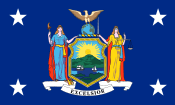John Broome (politician)
John Broome (1738 – August 8, 1810) was an American merchant and politician who was Lieutenant Governor of New York, from 1804 to 1810.
Life
Born on Staten Island, Broome studied law with William Livingston, but about 1762 abandoned a legal career to join his brother Samuel in a partnership to import British goods. In 1769, he married Rebecca Lloyd (1747-bef. 1803) and they had several children, among them John Lloyd Broome (d. 1836) who was the father of U.S. Navy officer John L. Broome (1824–1898).
He was a member of the New York Provincial Congress from 1775 to 1777, and a delegate to the New York State Constitutional Convention in 1777. He was an Alderman in 1783-84 and 1785–86, and New York City Treasurer in 1784.
He was the president of the New York City Chamber of Commerce from 1785 to 1794, and was engaged in the trade with India and China at that time. He is said to have launched the importation of tea from China with an initial shipment of 2 million pounds.[1]
In August 1795, during an outbreak of yellow fever, he was the chairman of the city's Health Committee, appointed by Governor George Clinton the previous year, and kept on by Clinton's rival John Jay despite Broome's prominence at a partisan rally to oppose the treaty Jay had just negotiated with the British, since health was not considered a partisan issue. The health committee denied there was an epidemic and played down the number of deaths, attributing them to other causes.
Broome twice ran unsuccessfully for U.S. Congress; first in March 1789 against Federalist candidate John Laurance, and then again in April 1802 against Federalist candidate Joshua Sands. Broome was a member from New York County of the New York State Assembly in 1800-01 and 1802, and a member of the New York State Senate in 1804.
Broome was elected Lieutenant Governor of New York three times, serving from July 1804 until his death in office in August 1810. He initially defeated Oliver Phelps in 1804, and then won re-election over Thomas Storm in 1807 and Nicholas Fish in 1810. He served under two Governors of New York—first under Morgan Lewis (1804–1807), and then under Daniel D. Tompkins (1807–1810). Broome's death occurred a month into his third term, so that at first the President pro tempore of the State Senate John Tayler became acting lieutenant governor, and in April 1811 DeWitt Clinton won a special election to serve for the remainder of the term.
On July 9, 1806, Broome married Ruth Hunter (c.1757–1840), the widow of auctioneer Robert Hunter (c.1735–1800) and mother of State Senator John Hunter (1778–1852).
Broome's remains were initially buried in the churchyard of the First Presbyterian Church in New York on Wall Street in New York City. However, they were moved in the 1840s when the church relocated to Fifth Avenue between 11th and 12th Streets in Greenwich Village in Manhattan.
Marine Corps officer John L. Broome (1824–1898) was his grandson.
Broome County, New York and the Town of Broome in Schoharie County, New York are named after him, as well as Broome Street in Manhattan in New York City.
Sources
- New York yellow fever epidemic in 1795 at the Wayback Machine (archived October 28, 2009)
- First Presbyterian Church in New York City
- The Documentary History of the First Federal Elections, 1788-1790 by Merrill Jensen, Robert A. Becker & Gordon DenBoer (University of Wisconsin Press, 1976, ISBN 0-299-10650-0, ISBN 978-0-299-10650-8 ; page 558)
- The New York Civil List compiled by Franklin Benjamin Hough (pages 32, 139 and 261; Weed, Parsons and Co., 1858)
- The Old Merchants of New York City by Joseph Alfred Scoville (Carleton, 1865; pages 208ff)
References
- ↑ New York: A Guide to the Metropolis, by Gerard R. Wolfe, p. 185.
| Political offices | ||
|---|---|---|
| Preceded by Jeremiah Van Rensselaer |
Lieutenant Governor of New York 1804–1810 |
Succeeded by John Tayler Acting |

